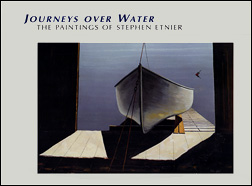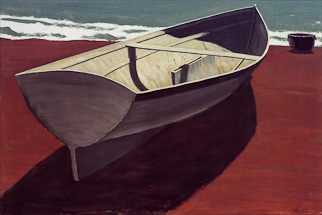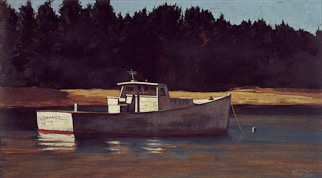 |
|||||||||||||||
|
|
|||||||||||||||
 |
|||||||||||||||
|
Journeys over Water
Essay for the 1998 exhibition catalog by Daniel. E. O'Leary, curator courtesy of Portland Museum of Art reproduced by permission. Presented in four parts: Introduction | I | II | III |
|||||||||||||||
|
III. Serenity: 1970 to 1984
The paintings of the final decades of Etnier's career increase in scale and in equanimity. His palette becomes softer and more natural, yielding warmer colors and subtle harmonies. The paintings reveal the delicate action of his brush and the use of thin glazes that allow layers of underpainting to glow through to and enrich the surface. His work grows increasingly Spartan and is characterized by grace, simplicity, and a refined sensitivity to light. Whitehall depicts the pure and elegant presence of a boat and its shadow, isolated on a tawny and uncluttered beach. The movements of the breakers are reduced to soft ribbons of zinc white that mediate between ocean and shore. The interior surface of the boat glows with the mellow texture of sun-baked paint. The shadow cast by the horizontal thwart articulates the interior curve of the hull and the perpendicular projection of the centerboard well. The graceful lines of the vessel are sculpted by radiant light. Few, if any, new subjects are introduced during the last fifteen years of his life. Instead Etnier seemed determined to revisit and refine the fundamental concerns of his earlier periods. His last paintings are ultimate variations on his favorite themes. Many of the earlier subjects and scenes are redefined with self-confidence and restraint. In these pictures there may appear to be an excess of vacant space until one observes that the real content of the painting is the light itself, and that light is the coherent forced that unites these objects and environments. Water and light enrich and empower Etnier's last paintings and allow him to refine the fundamental qualities that were always present in his art. In the paintings of the 1970s there emerges a serenity that becomes the final Etnier signature. (15) Because of the gradations of color and variations of light in Etnier's late paintings, the pictures must be meticulously lighted to reveal the depth of observation they convey. They represent Etnier's final artistic statements on luminosity. In Lobster Boat, a rich and opaque wall of pines provides the illusion of a vibrant forest with extreme economy: trees and foliage are represented not with lines, but with patches of shadow and light. Etnier not only provides a powerful impression of the light reflecting upon wood and water, but also sets a faint haze above the boat that rises like a subtle, atmospheric scrim between the viewer and the trees. The radiant features of the painting are so pronounced that we respond to it more as a harmony of shadows and reflections than as a representation of a vessel. Like Edward Hopper, Etnier frequently painted individual buildings within spare and evocative landscapes. Hopper's buildings seem vaguely animate. Their forms are soft and their geometry is lax and unregimented. They often exhibit a shabbiness that provokes sympathy. In almost exact opposition, Etnier's buildings and landmarks are severe and antipathetic. They exist in active tension with the human figure, in relationships that are alien and surreal. They seem to suggest an architecture of memory, or of dreams. Etnier's work has always been placed firmly within the camp of realism. The fact that his paintings demonstrate a strong inclination towards abstraction has rarely been discussed. Yet there are many features in his work that are inherently at odds with realist painting. His highly idiosyncratic style favored rigid lines, angular forms, eccentric patterns, and particularly in the 1960s highly artificial colors. A sophisticated manipulator of geometric forms, grids, and cryptic patterns, Etnier painted abstractions that ostensibly function as landscapes. (16) His surfaces rarely act as simple representations, but instead perform abstract and decorative roles. His treatment of the human figure is always subjective and abbreviated. Stephen Etnier was often identified during his lifetime as a romantic realist. (17) This stems predominantly from the inherent charm of his paintings and from his preoccupation with nature and with exotic locations. Like many members of the nineteenth-century romantic movement, Etnier was attracted to landscape as a means of escaping from social systems and exploring the elemental and poetic aspects of nature. Although Etnier did not entirely reject society, he gravitated towards the incongruous, the eccentric, and the peripheral, His more successful and evocative paintings questions the significance of human constructions and engage his viewers in admiring the atmosphere, texture, and illumination of the natural world. The central element in Etnier's romanticism, however, was not his choice of subject matter, but rather his implicit trust in the inner self and his devotion to individual experience. He was profoundly romantic in his commitment to the intuitive and the subjective. He not only favored themes that are associated with romanticism, but personified the intense individuality that is the dynamic spirit of romanticism. Daniel E. O'Leary
|
|||||||||||||||
 |
|||||||||||||||
| Whitehall, late 1970's private collection |
|||||||||||||||
 |
|||||||||||||||
| Lobster Boat, late 1970's private collection |
|||||||||||||||